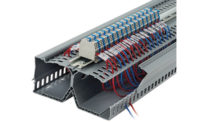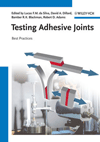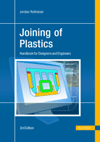When the best adhesive for a bonding application is a two-part formula that must be mixed before application, engineers sometimes avoid using it because they can't be certain it will be mixed correctly.
3M Automotive has commercialized a new technology that can improve control over the mixing of two-part adhesives. The technology--called a tagged adhesive--contains a special particle that allows the adhesive to be electronically monitored so the right amounts of resin and catalyst are combined and applied.
More two-part adhesives are finding their way into automotive joining applications, such as bonding the hem flange of inner and outer closure panels. Two-part adhesives used for these joints offer performance attributes that one-part adhesives can't match. They have a longer shelf life. They cure reliably at room temperature or with heating. They provide better holding power as parts pass through electrocoating and painting processes. And, they work despite oil contamination on metal parts.
Many of these attributes are influenced by the adhesive's mix ratio. Optimal performance occurs when the two parts are mixed together at the designated ratio. Common mix ratios are 1-to-1, 2-to-1, 4-to-1 and 10-to-1, by volume. In general, the higher the mix ratio, the less off-ratio tolerance the adhesive shows. Automotive OEMs expect two-part adhesives to exhibit no significant change in performance when mixed 10 percent off-ratio.
Despite improvements in dispensing equipment, so-called "off-ratio events" can occur. When this happens, dozens or even hundreds of parts can be made using adhesive mixed at the wrong ratio.
Tagged adhesives can prevent this problem. To tag a two-part adhesive, a metal-coated glass bubble--the taggant--is added to one of the parts. This particle can be added to nearly any adhesive. If the adhesive already contains uncoated glass bubbles, the adhesive can be tagged by substituting coated bubbles for uncoated bubbles. Compared with the original adhesive, the flow properties of the tagged adhesive remain essentially the same because the coated and uncoated bubbles have a very similar particle size distribution. The coating on the bubble is very thin, so the amount of metal added is very small. And the metal itself--a stainless steel--is chemically inert.
These metal-coated bubbles are detected by a pair of eddy current sensors as the adhesive passes through a dispensing system. The signal strength registered by the sensor is related to the concentration of the taggant in the tagged side of the two-part adhesive. When the tagged side is mixed with the untagged side, that signal strength drops. By measuring the original signal strength and the dropped signal strength, one can determine the mix ratio of the adhesive that is dispensed.
Tagging lets engineers monitor the adhesive's mix ratio continuously or intermittently. Information about the mix ratio of adhesive used on each part can be collected. Control charts can be continually updated to show the variation in mix ratio over time and to alert operators to deviations of mix ratio beyond acceptable limits.
Although optimization of the mix ratio is currently done separately from monitoring of the mix ratio, future generations of dispensing equipment will have feedback loops that automatically adjust pressure and other factors that determine mix ratio.
In automotive plants, most adhesive dispensing is done using meter, mix and dispense systems. Most of those used for two-part adhesives are equipped with positive displacement mechanisms. Mixing is accomplished by forcing both parts of the adhesive through a static mixer, which is a tube several inches in length containing a mixing element having a screw-like or ladder-like design. The static mixer is mounted on the mixing head where parts A and B emerge from the dispensing lines. During operation, high pressures force the adhesive through the convoluted channels inside the static mixer, and this folds the two parts together so that what emerges from the other end is well-mixed.
In an automotive plant, operators ensure that both parts of the adhesive are being correctly measured by performing a mix-ratio check, popularly known as the "Dixie cup method." For safety reasons, lines usually have to be shut down before someone can enter the dispensing area to run the mix-ratio check. The mixing nozzle is taken off the mixing head. The operator holds two paper cups under the mixing head and presses a button that briefly discharges parts A and B into the separate cups. The cups are weighed and the mix ratio determined by comparing the masses of adhesive in each cup.
This method has several shortcomings. First, the line must be shut down for about 10 minutes for the check to be done, resulting in lost productivity. Second, mix ratio checks are usually done only once per shift, usually every 8 or 12 hours. If an off-ratio event occurs, hundreds of faulty parts can be made before the next check discovers the problem. Third, the Dixie cup method uses about an ounce of adhesive to represent all the material dispensed onto hundreds of parts. Because the entire shot of adhesive is checked for mix ratio conformance, no information can be gained about the change in mix ratio through each dispensing cycle. Finally, the small amount of material collected in the Dixie cup method is ejected at very low pressures with virtually no back pressure. Any leaks or other defects up-line from the dispensing head will not be readily detected at these low pressures. Moreover, a mix ratio generated from low pressure dispensing may not fairly represent the state of the adhesive dispensed under high pressure.
Mix ratio monitoring is only one of several capabilities of tagged adhesives. For example, because magnetic fields can readily penetrate nonferrous substrates, such as aluminum and plastic composites, engineers can use eddy current techniques to "see" tagged adhesives through already bonded parts. Costly teardowns of closure panels could become unnecessary with implementation of nondestructive testing enabled by tagged adhesives. One-hundred-percent part inspection may become a reality.
3M's major partner in introducing tagged adhesives is Ford Motor Co.'s Advanced Manufacturing and Technology Development Center (Dearborn, MI). In the late 1990s, Ford conducted small trials with tagged adhesives at its assembly plant in Wixom, MI, and its stamping plant in Chicago Heights, IL. In spring 2000, the Chicago Heights plant began using a tagged adhesive full time to assemble hoods for Ford Ranger pickups.
For more information on tagged adhesives, call the 3M Automotive Innovations Center at 734-953-9300, visit www.3m.com/US/index.jhtml.




